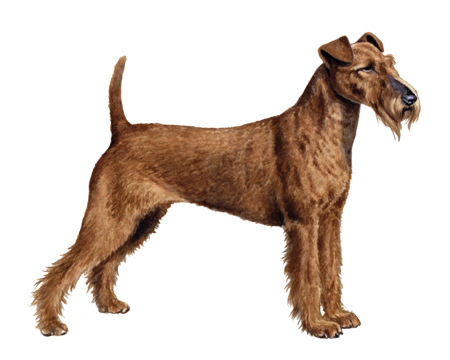
Lancashire Heeler
Alert and intelligent, Lancashire Heelers make excellent—albeit small—herding dogs. At home, they're happy-go-lucky, chatty, affectionate, and always up for a walk.
Interested in discovering if your dog is a Lancashire Heeler?
Check out Wisdom Panel's DNA tests.

Lancashire Heeler Traits
General Appearance
Good things come in small packages. The Lancashire Heeler is a strong and observant little worker bee that moves neatly and quickly.
Sturdy, short-legged dogs, Lancashire Heelers are a little longer than they are tall. They carry their tails skyward with a bit of a curl. Their wide, flat heads taper a bit, and their almond-shaped eyes are set wide apart.
Coat and Coloring
The Lancashire Heeler’s dense double coat is either black and tan or liver and tan. A small, white chest blaze is also possible in this breed.
Distinctive Physical Traits
Lancashire Heelers have a unique characteristic that says, "I'm friendly and in a good mood." It's called the Heeler Smile: The dogs draw back their lips and actual smirk.
Lancashire Heeler Temperament
Loyal, courageous, and happy, the Lancashire Heeler is friendly and affectionate toward its family. However, it can be a rather watchful and cautious breed—making it an outstanding herding dog.
Some Lancashire Heelers may be wary of strangers and tend to bark a lot. They generally get along with children, but—like all dogs—should be closely supervised for the safety of everyone involved.

Lancashire Heeler History
As the name would suggest, the Lancashire Heeler (also known as the Ormskirk Heeler) originated in Lancashire, Northern England. Experts believe the early breed was a cross of Welsh Corgis—which were escorting herds to local markets—and the indigenous Manchester Terriers.
Lancashire Heelers have historically been used to round up cattle and sheep on farms by sharply nipping the herd's heels. They also served as expert ratters and rabbit hunters.
This short, black-and-tan-coated breed is uncommon outside of Northern England and rarely found outside of the United Kingdom—where it attained formal recognition by the Kennel Club in 1981. The American Kennel Club first listed the Lancashire Heeler on the Foundation Stock Service breed register in 1999.
Though their numbers are relatively low, Lancashire Heelers' cute appearance and energetic work ethic may make them superstars in the dog world yet.
Lancashire Heeler Care
Nutrition
Lancashire Heelers require a high-quality diet that is age-appropriate. Also, it's important to keep an eye on the amount of food your pup eats and reduce the portions if they gain weight. Remember that giving too many treats in addition to regular meals can contribute to obesity.
Grooming
Besides a light brushing or occasional bath, this breed requires very little grooming. However, Lancashire Heelers do need their nails trimmed to keep overgrowth, splitting, and cracking at bay.
You should also check your dog's ears often to avoid wax buildup and the accumulation of debris. Regular teeth-brushing should become a habit, as well.
Exercise
Lancashire Heelers like plenty of exercise, interaction with people, and brain games to keep busy. Outdoor playtime excites them, but you should limit it to fenced-in yards or dog parks, as these dogs are known to be escape artists. Of course, a few on-leash walks throughout the day are great options, too.
When indoors, Lancashire Heelers like to hide and be found, chase balls, and learn tricks. They also really dig dog sports—particularly earthdog trials.
Training
Quick to learn, the Lancashire Heeler responds well to reward-based training techniques with yummy treats and toys. This breed can be independent, though. So, training must be thoughtful but firm.
Lancashire Heeler Genetic Health Conditions
-
Amelogenesis Imperfecta (Discovered in the Lancashire Heeler)
Amelogenesis Imperfecta (AI), also known as enamel hypoplasia, is a disorder where the hard enamel covering of the teeth is thin, roughened, and discolored. Please note, the genetic variant tested by Wisdom is currently under research for association of AI in the Lancashire Heeler with a scientific manuscript in preparation.
-
Primary Lens Luxation
Primary Lens Luxation (PLL) is a condition that can cause the lens of the eye to become loose and eventually displace. The disorder is caused by degeneration of the fibers that hold the lens in place.
Knowing if your Lancashire Heeler is a carrier or at-risk for these conditions can help you and your veterinarian plan for your pup’s lifelong care. With Wisdom Panel™ Premium, you can get results for over 200 genetic health tests.
Breed Group
Terrier
The Terrier Group ancestors were bred to hunt and kill vermin. They are often characterized as feisty and energetic dogs whose sizes range from fairly small to much larger.
Resources
https://www.akc.org/dog-breeds/lancashire-heeler/
https://www.unitedstateslancashireheelerclub.com/
Reviewed July 26, 2020 by Cindy Elston, DVM, MPH





















































